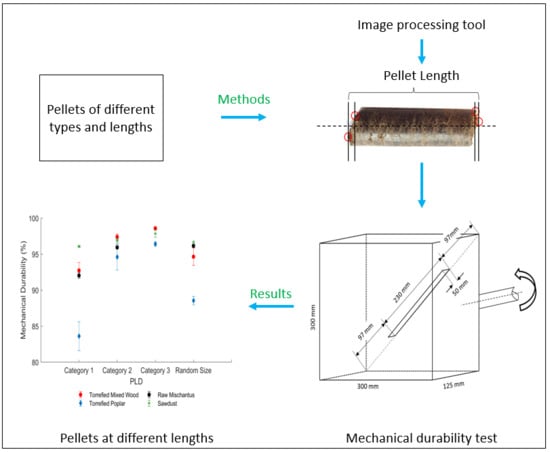The Effect of Biomass Pellet Length, Test Conditions and Torrefaction on Mechanical Durability Characteristics According to ISO Standard 17831-1
Abstract
1. Introduction
2. Materials and Methods
2.1. Materials
2.2. Methods
2.2.1. Determination of the Mechanical Durability
- Test case 1: Pellets with different length distributions.
- Test case 2: Pellets under different durability test conditions.
- Test case 3: Non-torrefied and torrefied pellets of the same origin.
2.2.2. Determination of the PLD
2.2.3. Validation of the Image Processing Tool
3. Results
3.1. Test Case 1
3.2. Test Case 2
3.3. Test Case 3
4. Discussion
5. Conclusions
- Regardless of the origin, pelletization process characteristics and pre-treatment processes, the tendency of biomass pellets to generate fines and dust (particles passing through 3.15 mm sieve holes) strongly depends on the pellet length.
- The lower the pellet length per unit mass, the higher the number of pellets and, therefore, the more collisions in the tumbling can that result in a higher fines content and thus lower mechanical durability. This is confirmed for all five tested materials.
- The length to diameter ratio can affect the mechanical durability results of different PLDs. A higher length to diameter ratio decreases the difference in mechanical durability values between all PLD categories.
- The observed breakage mechanism of biomass pellets is either fragmentation (breakage into smaller pellets) or abrasion. In this study, we show that most fines and dust in a tumbling can method are generated due to abrasion and not fragmentation.
- In this study, the effect of torrefaction was studied using a single torrefied pellet type (torrefied Miscanthus), and the mechanical durability characteristic was compared to a white pellet (raw Miscanthus). For the torrefied Miscanthus, the torrefaction process was performed after pellet production. For this specific pellet, the torrefaction process was not an influencing factor in the mechanical durability characteristics of Miscanthus pellets. For a better understanding of this result, the role of the torrefaction process conditions such as time and temperature, the process sequence and PLD should be further investigated by testing a wide range of raw and torrefied pellets.
Author Contributions
Funding
Acknowledgments
Conflicts of Interest
References
- Calderón, C.; Gauthier, G.; Jossart, J.-M. Bioenergy Europe Statistical Report 2019—Key Findings; European Association Bioenergy Europe: Brussels, Belgium, 2019. [Google Scholar]
- Hedlund, F.H.; Astad, J.; Nichols, J. Inherent hazards, poor reporting and limited learning in the solid biomass energy sector: A case study of a wheel loader igniting wood dust, leading to fatal explosion at wood pellet manufacturer. Biomass Bioenergy 2014, 66, 450–459. [Google Scholar] [CrossRef]
- Kaliyan, N.; Morey, R.V. Factors affecting strength and durability of densified biomass products. Biomass Bioenergy 2009, 33, 337–359. [Google Scholar] [CrossRef]
- ISO 16559. Solid Biofuels- Terminology, Definitions and Descriptions; ISO: Geneva, Switzerland, 2014. [Google Scholar]
- Temmerman, M.; Rabier, F.; Jensen, P.D.; Hartmann, H.; Böhm, T. Comparative study of durability test methods for pellets and briquettes. Biomass Bioenergy 2006, 30, 964–972. [Google Scholar] [CrossRef]
- ISO 17831-1. Solid Biofuels-Determination of Mechanical Durability of Pellets and Briquettes-Part 1: Pellets; ISO: Geneva, Switzerland, 2015. [Google Scholar]
- Riva, L.; Surup, G.R.; Buø, T.V.; Nielsen, H.K. A study of densified biochar as carbon source in the silicon and ferrosilicon production. Energy 2019, 181, 985–996. [Google Scholar] [CrossRef]
- Fernández-Puratich, H.; Hernández, D.; Arce, V.L. Characterization and cost savings of pellets fabricated from Zea mays waste from corn mills combined with Pinus radiata. Renew. Energy 2017, 114, 448–454. [Google Scholar]
- Miranda, M.T.; Sepúlveda, F.J.; Arranz, J.I.; Montero, I.; Rojas, C.V. Analysis of pelletizing from corn cob waste. J. Environ. Manag. 2018, 228, 303–311. [Google Scholar] [CrossRef]
- Tang, Y.; Chandra, R.P.; Sokhansanj, S.; Saddler, J.N. The Role of Biomass Composition and Steam Treatment on Durability of Pellets. Bioenergy Res. 2018, 11, 341–350. [Google Scholar] [CrossRef]
- Mohammadi Ghasem Abadi, M.H.; Moravej, H.; Shivazad, M.; Karimi Torshizi, M.A.; Kim, W.K. Effect of different types and levels of fat addition and pellet binders on physical pellet quality of broiler feeds. Poult. Sci. 2019, 98, 4745–4754. [Google Scholar] [CrossRef] [PubMed]
- Matúš, M.; Križan, P.; Šooš, Ľ.; Beniak, J. The effect of papermaking sludge as an additive to biomass pellets on the fi nal quality of the fuel. Fuel 2018, 219, 196–204. [Google Scholar] [CrossRef]
- Tumuluru, J.S. Pelleting of Pine and Switchgrass Blends: Effect of Process Variables and Blend Ratio on the Pellet Quality and Energy Consumption. Energies 2019, 12, 1198. [Google Scholar] [CrossRef]
- Dyjakon, A.; Noszczyk, T. The influence of freezing temperature storage on the mechanical durability of commercial pellets from biomass. Energies 2019, 12, 2627. [Google Scholar] [CrossRef]
- Gilvari, H.; Cutz, L.; Tiringer, U.; Mol, A.; de Jong, W.; Schott, D.L. The Effect of Environmental Conditions on the Degradation Behavior of Biomass Pellets. Polymers 2020, 12, 970. [Google Scholar] [CrossRef]
- SS 187120. Biofuels and Peat-Fuel Pellets; Classification-Swedish Standards Institution: Stockholm, Sweden, 1998. [Google Scholar]
- DIN 51731. Testing of Solid Fuels. Compressed Untreated Wood. Requirements and Testing-Deutsches Institut für Normung, Berlin, Germany; German National Standard: Berlin, Germany, 1996. [Google Scholar]
- DIN EN 15270. Pellet Burners for Small Heating Boilers. Definitions, Requirements, Testing, Marking; Deutsches Institut für Normung: Berlin, Germany, 2007. [Google Scholar]
- CTI—R 04/5. Recommendation: Solid Biofuels. Pellet Characterization for Energetic Purposes; Milan, Italy, 2004. [Google Scholar]
- ÖNORM, M. 7135: Compressed Wood or Compressed Bark in Natural State, Pellets and Briquettes, Requirements and Test Specifications; Osterreichisches Normungsinstitut: Vienna, Austria, 2000. [Google Scholar]
- ISO 17225-2. Solid Biofuels-Fuel Specifications and Classes—Part 2: Graded Wood Pellets; ISO: Geneva, Switzerland, 2014. [Google Scholar]
- Larsson, S.H.; Samuelsson, R. Prediction of ISO 17831-1: 2015 mechanical biofuel pellet durability from single pellet characterization. Fuel Process. Technol. 2017, 163, 8–15. [Google Scholar] [CrossRef]
- Williams, O.; Taylor, S.; Lester, E.; Kingman, S.; Giddings, D.; Eastwick, C. Applicability of mechanical tests for biomass pellet characterisation for bioenergy applications. Materials 2018, 11, 1329. [Google Scholar] [CrossRef]
- Chico-Santamarta, L.; Chaney, K.; Godwin, R.J.; White, D.R.; Humphries, A.C. Physical quality changes during the storage of canola (Brassica napus L.) straw pellets. Appl. Energy 2012, 95, 220–226. [Google Scholar] [CrossRef]
- Serrano, C.; Monedero, E.; Lapuerta, M.; Portero, H. Effect of moisture content, particle size and pine addition on quality parameters of barley straw pellets. Fuel Process. Technol. 2011, 92, 699–706. [Google Scholar] [CrossRef]
- Bourgeois, J.P.; Doat, J. Torrefied wood from temperate and tropical species. Advantages and prospects. In Bioenergy 84. Proceedings of Conference 15–21 June 1984, Goteborg, Sweden. Volume III. Biomass Conversion; Elsevier Applied Science Publishers: London, UK, 1984; pp. 153–159. [Google Scholar]
- Arias, B.; Pevida, C.; Fermoso, J.; Plaza, M.G.; Rubiera, F.; Pis, J.J. Influence of torrefaction on the grindability and reactivity of woody biomass. Fuel Process. Technol. 2008, 89, 169–175. [Google Scholar] [CrossRef]
- Stelte, W.; Clemons, C.; Holm, J.K.; Sanadi, A.R.; Ahrenfeldt, J.; Shang, L.; Henriksen, U.B. Pelletizing properties of torrefied spruce. Biomass Bioenergy 2011, 35, 4690–4698. [Google Scholar] [CrossRef]
- Rudolfsson, M.; Borén, E.; Pommer, L.; Nordin, A.; Lestander, T.A. Combined effects of torrefaction and pelletization parameters on the quality of pellets produced from torrefied biomass. Appl. Energy 2017, 191, 414–424. [Google Scholar] [CrossRef]
- Larsson, S.H.; Rudolfsson, M.; Nordwaeger, M.; Olofsson, I.; Samuelsson, R. Effects of moisture content, torrefaction temperature, and die temperature in pilot scale pelletizing of torrefied Norway spruce. Appl. Energy 2013, 102, 827–832. [Google Scholar] [CrossRef]
- EN 16127. Solid Biofuels—Determination of Length and Diameter of Pellets; European Committee for Standardization: Brussels, Belgium, 2012. [Google Scholar]
- ISO 18134-2. Solid Biofuels—Determination of Moisture Content- Oven Dry Method—Part 2: Total Moisture-Simplified Method; ISO: Geneva, Switzerland, 2017. [Google Scholar]
- Graham, S.; Eastwick, C.; Snape, C.; Quick, W. Mechanical degradation of biomass wood pellets during long term stockpile storage. Fuel Process. Technol. 2017, 160, 143–151. [Google Scholar] [CrossRef]
- Graham, S.; Ogunfayo, I.; Hall, M.R.; Snape, C.; Quick, W.; Weatherstone, S.; Eastwick, C. Changes in mechanical properties of wood pellets during artificial degradation in a laboratory environment. Fuel Process. Technol. 2016, 148, 395–402. [Google Scholar] [CrossRef]
- ISO 17827-1. Solid Biofuels-Determination of Particle Size Distribution for Uncompressed Fuels-Part: Oscillating Screen Method Using Sieves with Apertures of 3.15 mm and Above; ISO: Geneva, Switzerland, 2016. [Google Scholar]
- Gil, M.; Teruel, E.; Arauzo, I. Analysis of standard sieving method for milled biomass through image processing. Effects of particle shape and size for poplar and corn stover. Fuel 2014, 116, 328–340. [Google Scholar] [CrossRef]
- Thomas, M. Physical Quality of Pelleted Feed: A Feed Model Study; Thomas: Wageningen, The Netherlands, 1998. [Google Scholar]
- Gilvari, H.; de Jong, W.; Schott, D.L. Quality parameters relevant for densification of bio-materials: Measuring methods and affecting factors—A review. Biomass Bioenergy 2019, 120, 117–134. [Google Scholar] [CrossRef]
- Manouchehrinejad, M.; Mani, S. Torrefaction after pelletization (TAP): Analysis of torrefied pellet quality and co-products. Biomass Bioenergy 2018, 118, 93–104. [Google Scholar] [CrossRef]
- Shang, L.; Nielsen, N.P.; Dahl, J.; Stelte, W.; Ahrenfeldt, J.; Holm, J.K.; Thomsen, T.; Henriksen, U.B. Quality effects caused by torrefaction of pellets made from Scots pine. Fuel Process. Technol. 2012, 101, 23–28. [Google Scholar] [CrossRef]

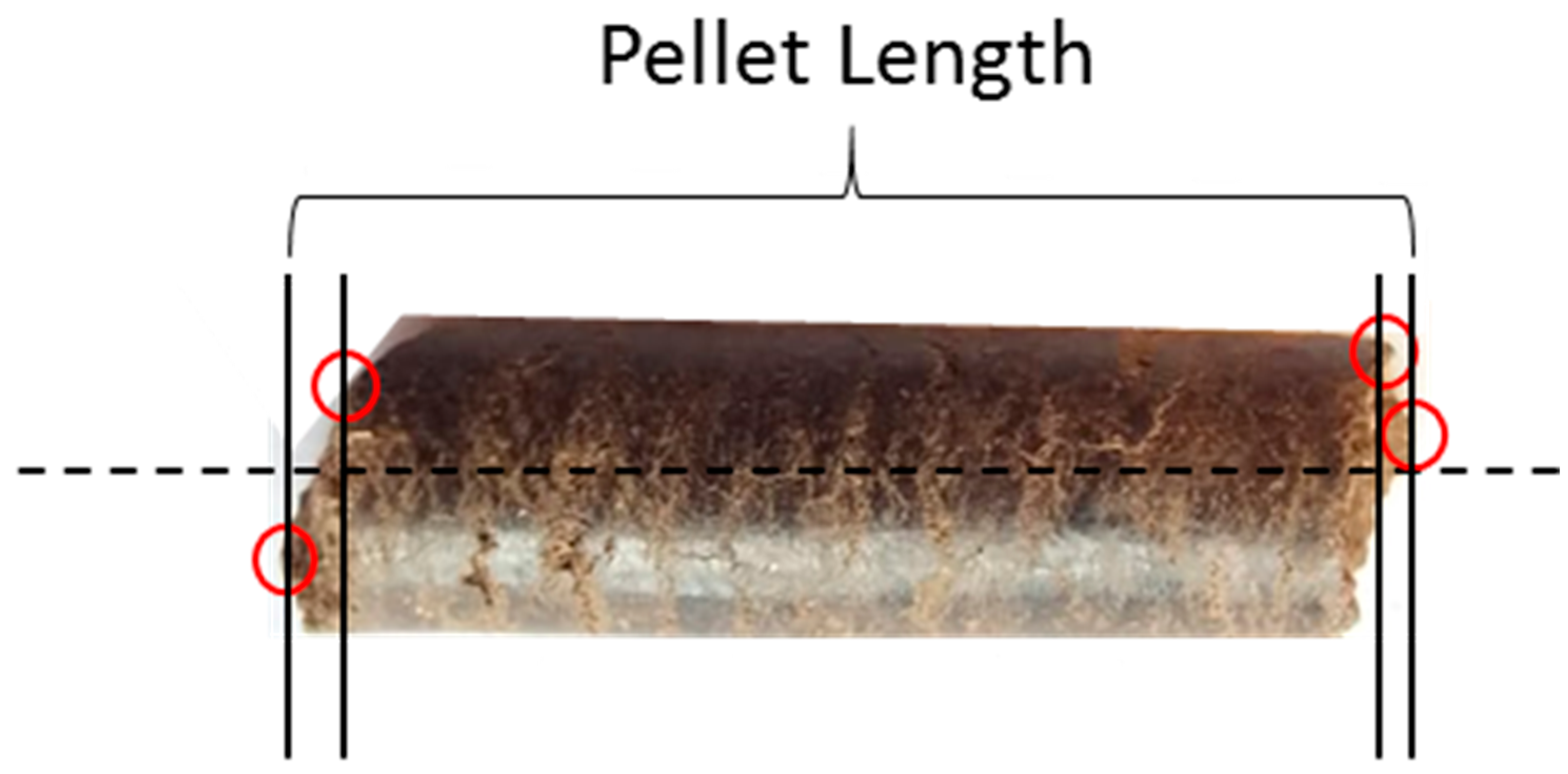
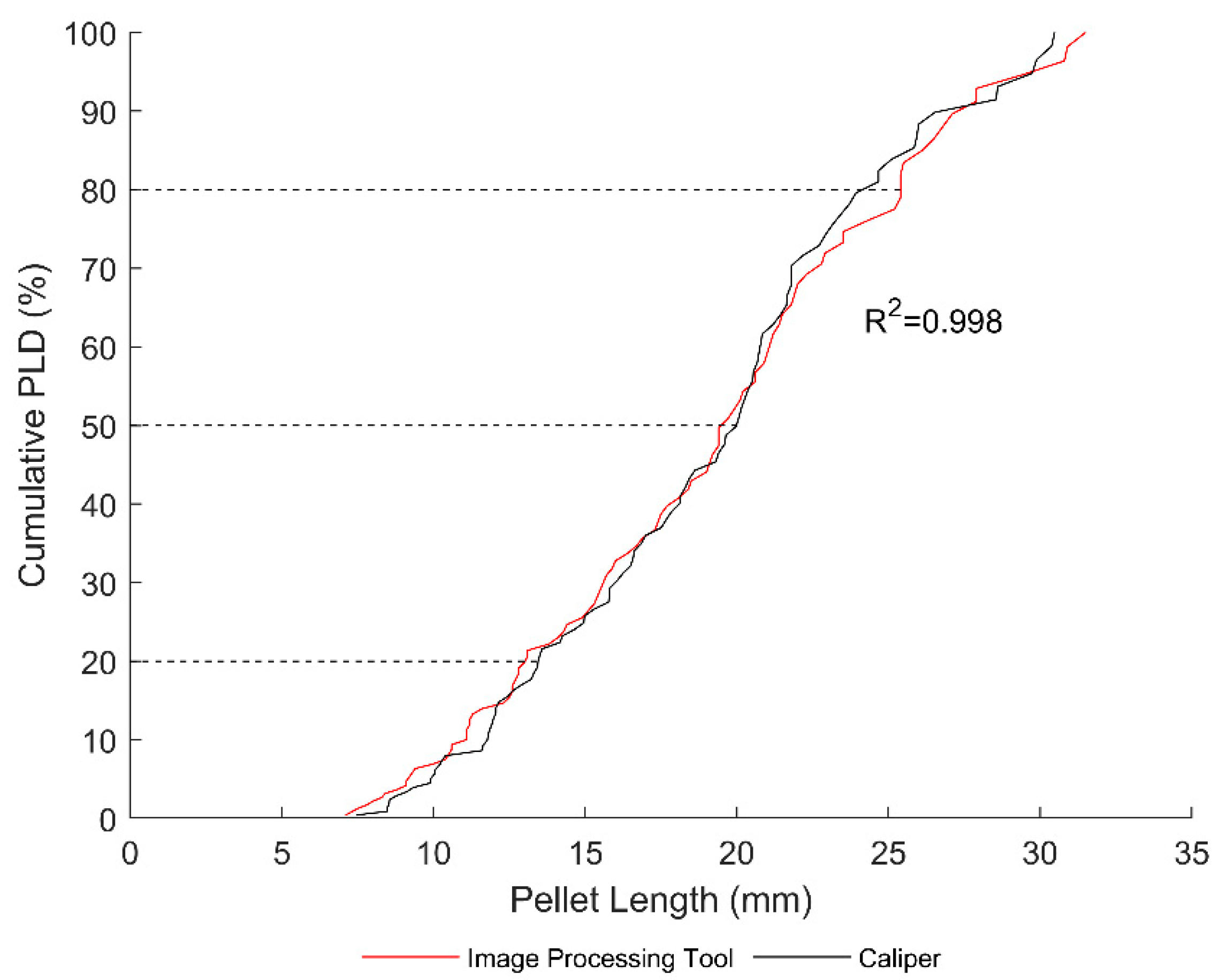
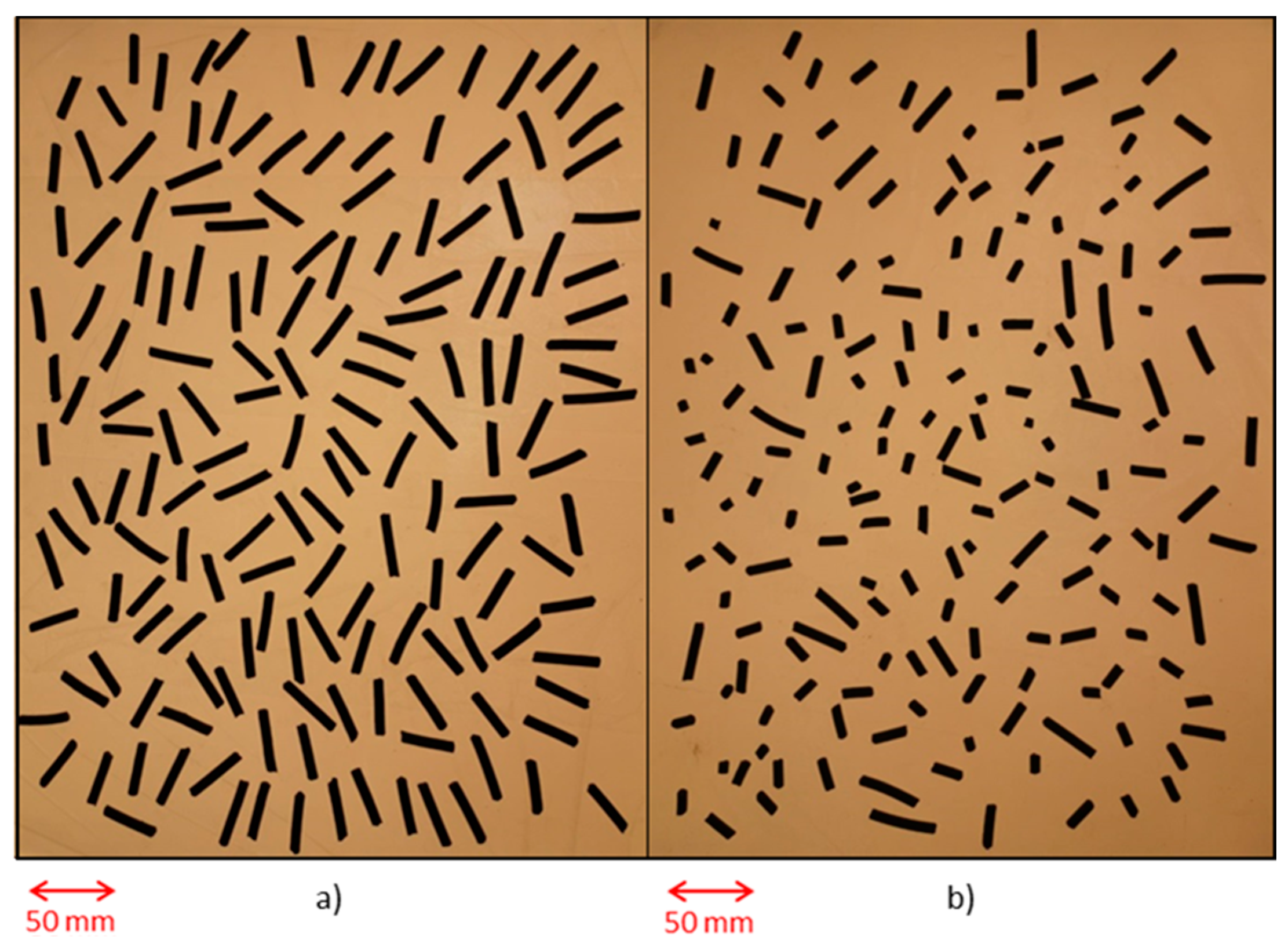

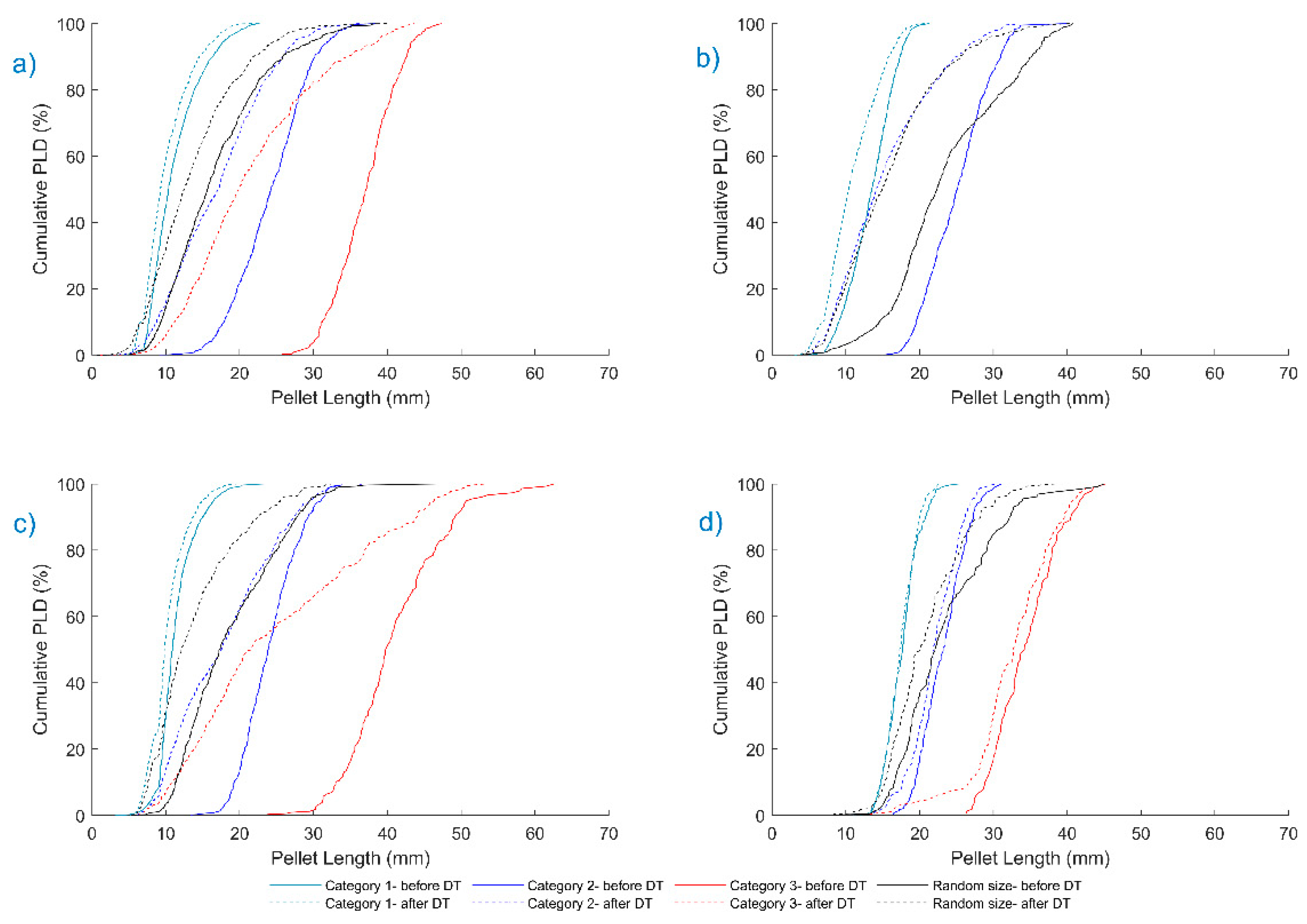
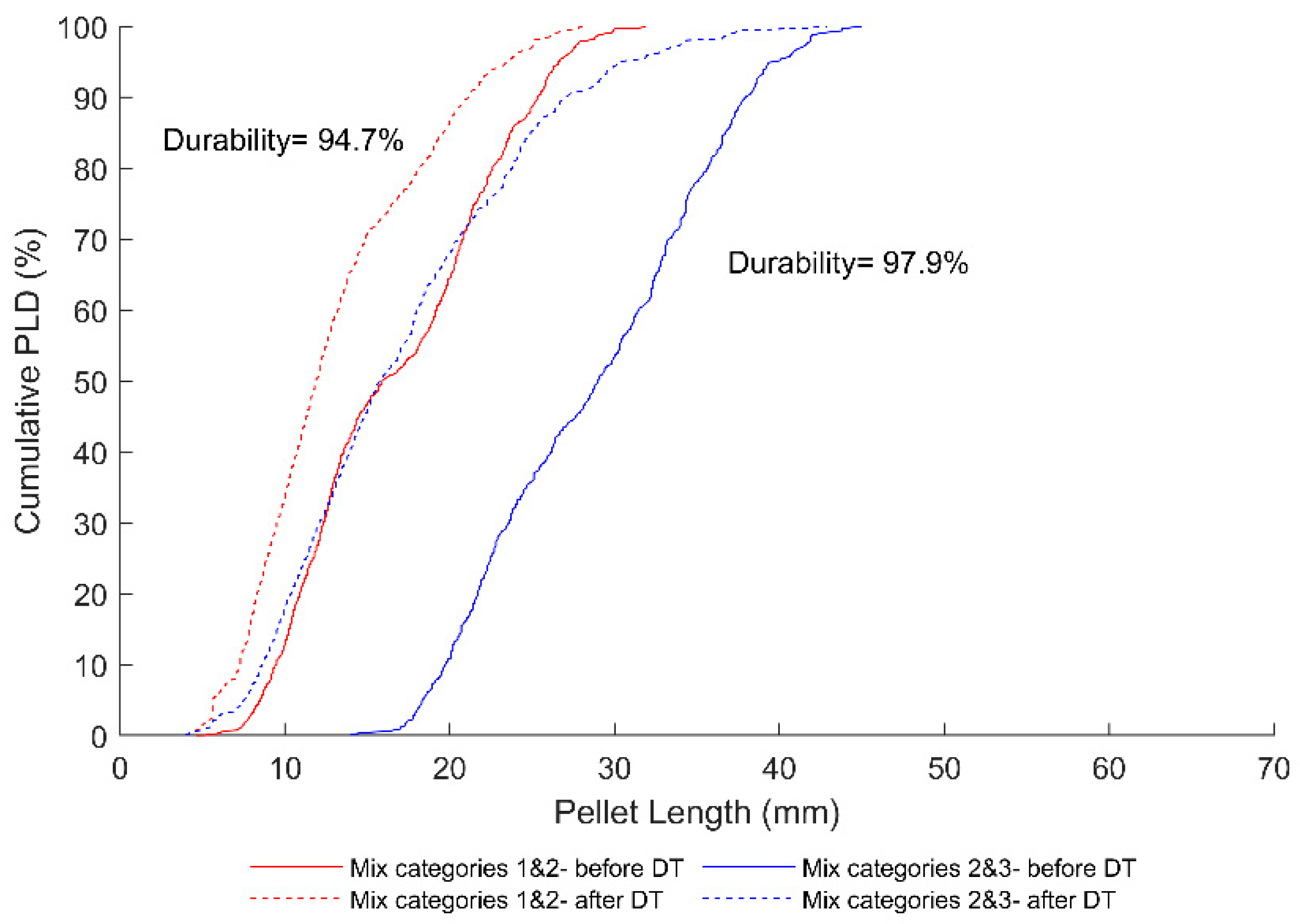
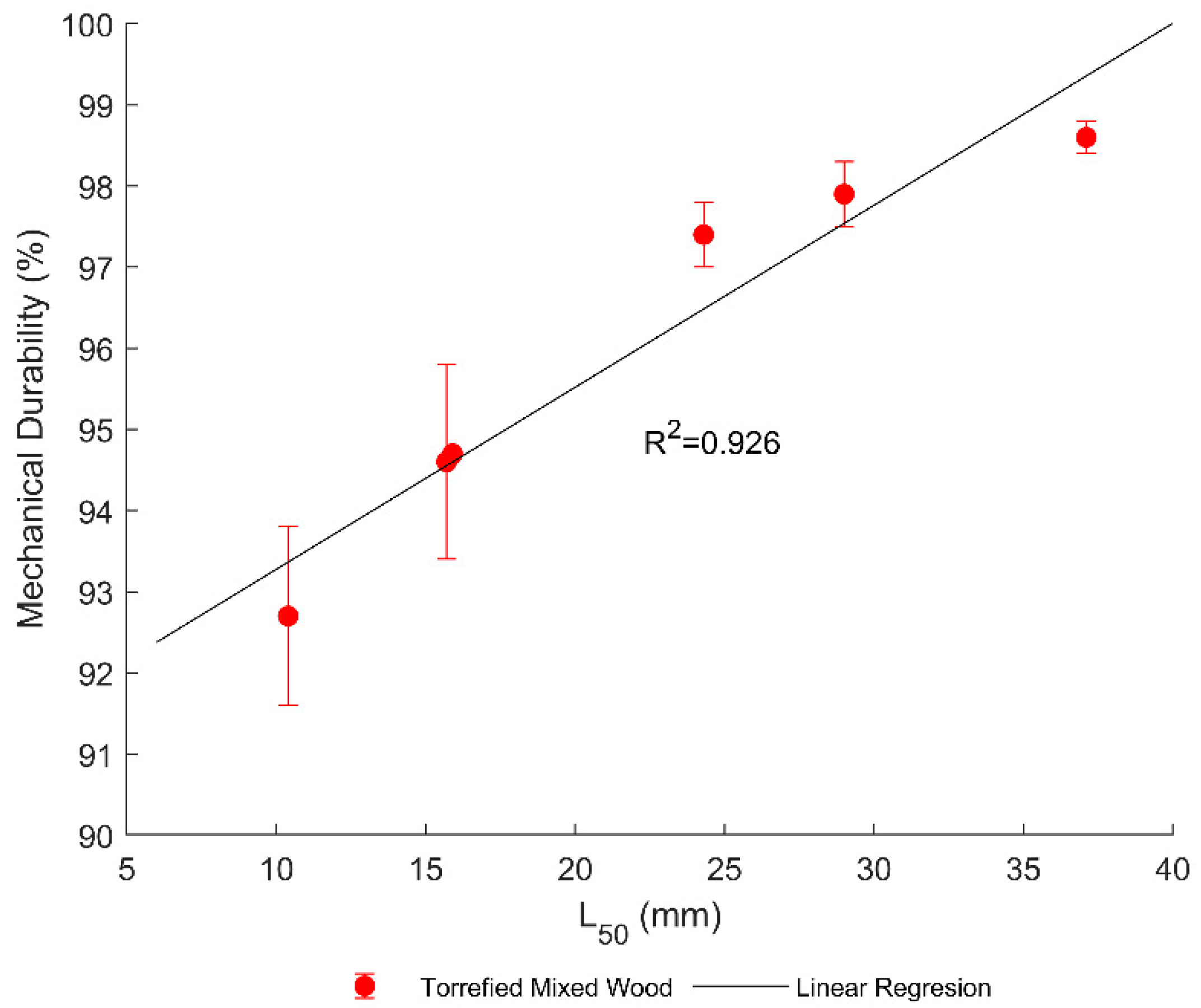
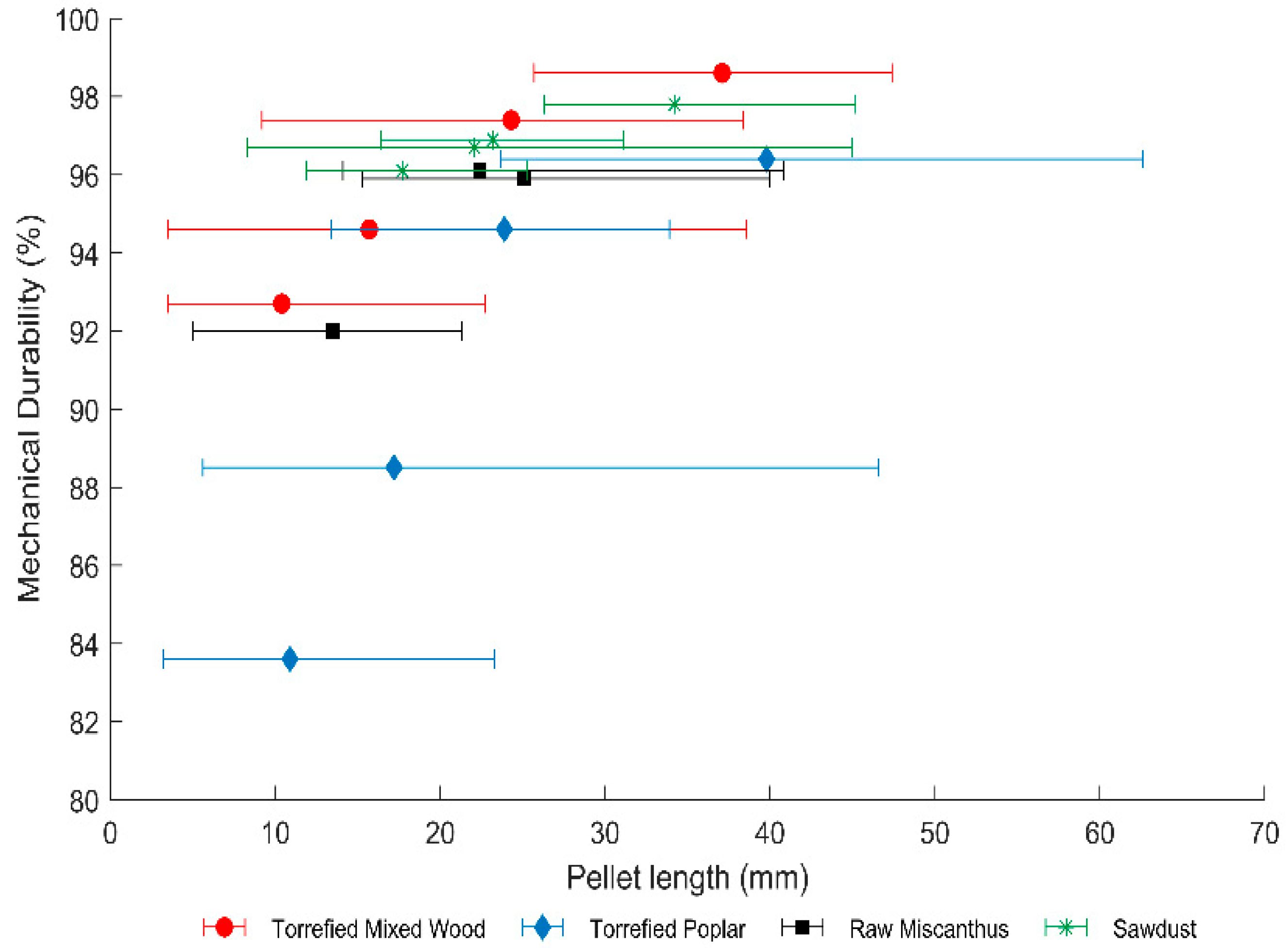

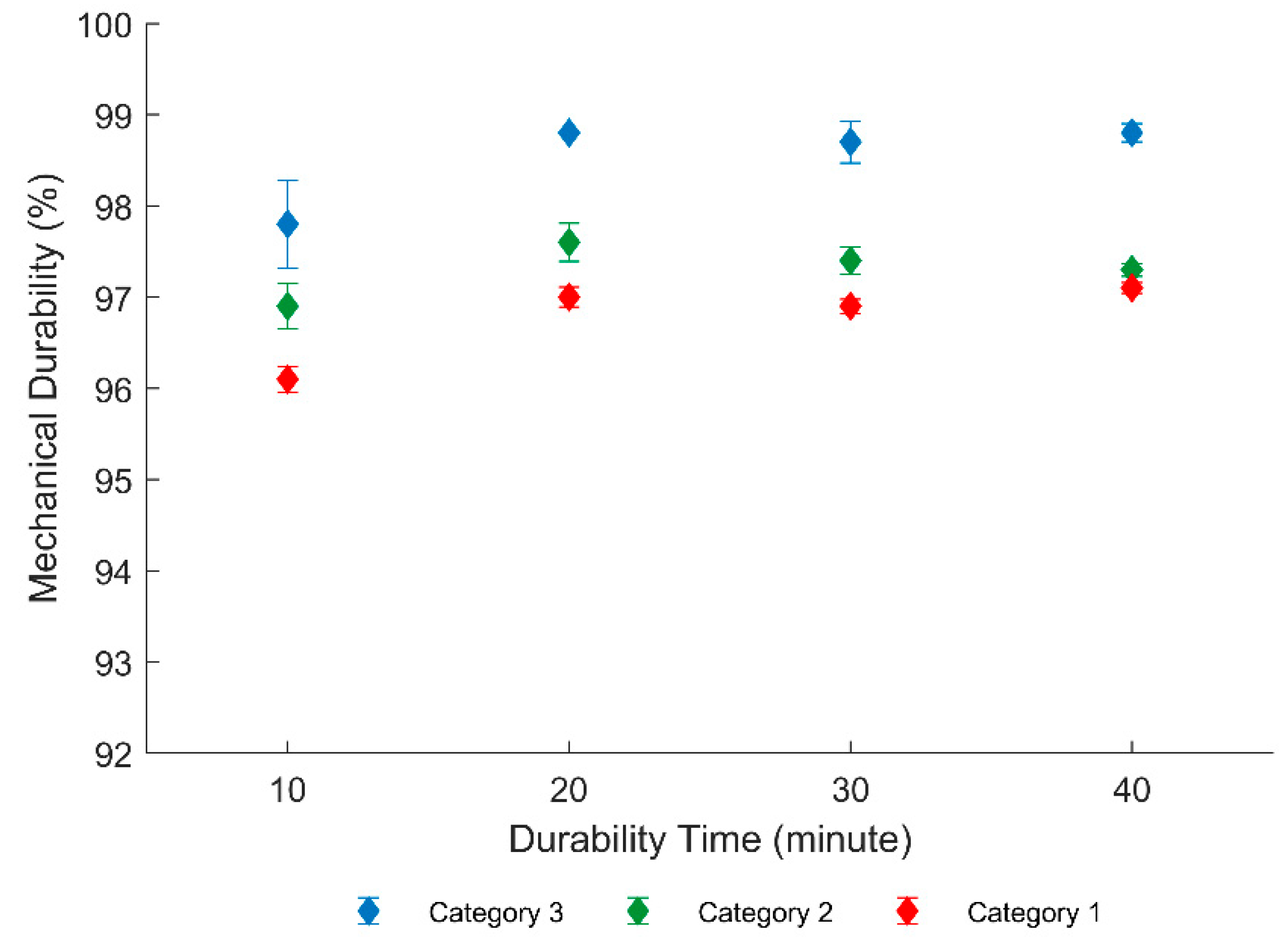

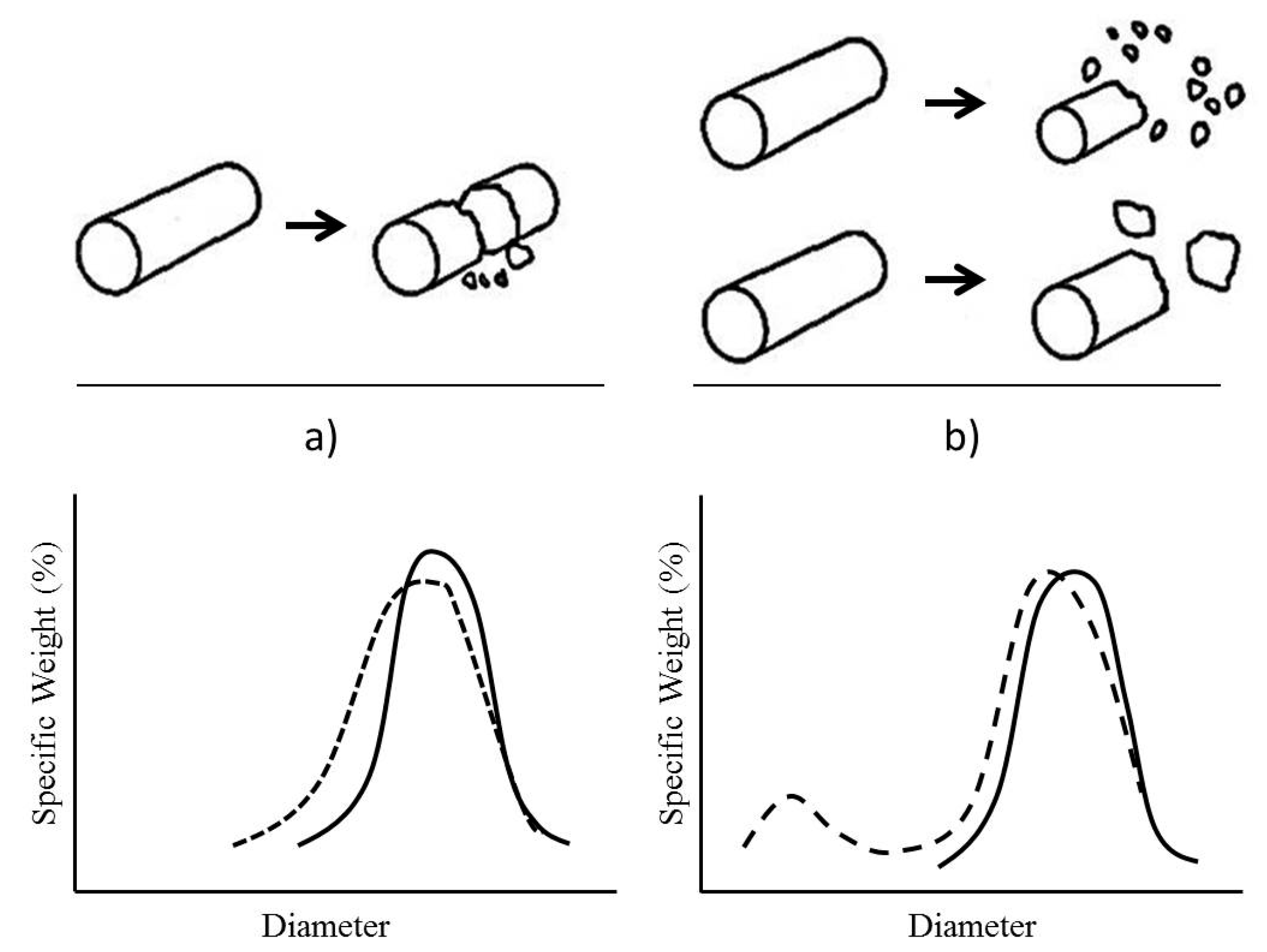
| Sample | Diameter (mm) | Length (mm) | Length/Diameter Ratio (-) | Moisture (%) | Pellet Density (kg·m−3) |
|---|---|---|---|---|---|
| Sawdust | 12.49 ± 0.15 | 10.00–46.30 | 0.80–3.71 | 7.7 | 1150 ± 37 |
| Raw miscanthus | 6.10 ± 0.03 | 5.00–40.00 | 0.82–6.56 | 4.5 | 1320 ± 64 |
| Torrefied miscanthus | 6.00 ± 0.08 | 4.00–41.70 | 0.64–6.95 | 2.9 | 1109 ± 22 |
| Torrefied poplar | 8.09 ± 0.07 | 5.50–65.90 | 0.68–8.15 | 7.9 | 1126 ± 62 |
| Torrefied mixed wood | 6.02 ± 0.04 | 4.10–47.40 | 0.68–7.87 | 9.7 | 1304 ± 40 |
| Sample | PLD | L50 (mm) | Number of Pellets | |||
|---|---|---|---|---|---|---|
| Before DT 1 | After DT | % of Change | Before DT | After DT | ||
| Raw miscanthus | Category 1 | 13.5 | 10.2 | 24.4 | 1329 | 1661 |
| Category 2 | 25.1 | 14.1 | 43.8 | 612 | 1181 | |
| Random size | 22.4 | 14.9 | 33.5 | 721 | 1165 | |
| Torrefied poplar | Category 1 | 10.9 | 9.8 | 10.1 | 1553 | 1498 |
| Category 2 | 23.9 | 17.5 | 26.8 | 420 | 700 | |
| Category 3 | 39.8 | 21.6 | 45.7 | 225 | 477 | |
| Random size | 17.2 | 12.1 | 29.6 | 730 | 955 | |
| Torrefied mixed wood | Category 1 | 10.4 | 9 | 13.5 | 2241 | 1785 |
| Category 2 | 24.3 | 17.1 | 29.6 | 658 | 1094 | |
| Category 3 | 37.1 | 19.9 | 46.4 | 404 | 857 | |
| Random size | 15.7 | 12.5 | 20.4 | 1075 | 1498 | |
| Sawdust | Category 1 | 17.7 | 17.3 | 2.3 | 386 | 379 |
| Category 2 | 23.2 | 21.9 | 5.6 | 216 | 224 | |
| Category 3 | 34.2 | 32.7 | 4.4 | 125 | 136 | |
| Random size | 22.1 | 19.6 | 11.3 | 245 | 244 | |
| Sample No. | Uniaxial Compression | Diametrical Compression | ||||||
|---|---|---|---|---|---|---|---|---|
| Raw Miscanthus | Torrefied Miscanthus | Raw Miscanthus | Torrefied Miscanthus | |||||
| (MPa) | (-) | (MPa) | (-) | (MPa) | (-) | (MPa) | (-) | |
| µ | 17.64 | 0.05 | 13.43 | 0.08 | 16.04 | 0.07 | 9.95 | 0.10 |
| Standard deviation | 0.66 | 0.01 | 1.44 | 0.02 | 2.64 | 0.01 | 2.84 | 0.02 |
© 2020 by the authors. Licensee MDPI, Basel, Switzerland. This article is an open access article distributed under the terms and conditions of the Creative Commons Attribution (CC BY) license (http://creativecommons.org/licenses/by/4.0/).
Share and Cite
Gilvari, H.; De Jong, W.; Schott, D.L. The Effect of Biomass Pellet Length, Test Conditions and Torrefaction on Mechanical Durability Characteristics According to ISO Standard 17831-1. Energies 2020, 13, 3000. https://doi.org/10.3390/en13113000
Gilvari H, De Jong W, Schott DL. The Effect of Biomass Pellet Length, Test Conditions and Torrefaction on Mechanical Durability Characteristics According to ISO Standard 17831-1. Energies. 2020; 13(11):3000. https://doi.org/10.3390/en13113000
Chicago/Turabian StyleGilvari, Hamid, Wiebren De Jong, and Dingena L. Schott. 2020. "The Effect of Biomass Pellet Length, Test Conditions and Torrefaction on Mechanical Durability Characteristics According to ISO Standard 17831-1" Energies 13, no. 11: 3000. https://doi.org/10.3390/en13113000
APA StyleGilvari, H., De Jong, W., & Schott, D. L. (2020). The Effect of Biomass Pellet Length, Test Conditions and Torrefaction on Mechanical Durability Characteristics According to ISO Standard 17831-1. Energies, 13(11), 3000. https://doi.org/10.3390/en13113000





